#North American cave lion
Text

NEW SUNNY ART YAY!!!!!!
Artwork and Character by me
Character: Sunny The North American Cave Lion
#kidcore#clown#clowncore#rainbowcore#kidcore fashion#cave lion furry#cave lion fursona#cave lion oc#cave lion#North American cave lion#paleo fursona#paleo furry#extinct animal fursona#furry#furry sfw#art#artwork#art by me
10 notes
·
View notes
Text




Carnivoran skulls from the Florida Museum of Natural History:
Lesser short-faced bear (Arctodus pristinus). Became extinct around 300,000 years ago, fossils are found in high concentrations in Florida. Related to the modern spectacled bear.
Ambruster’s wolf (Canis ambrusteri). Became extinct around 250,000 years ago, found throughout the United States. Taxonomy of this species is somewhat confusing, it may be related to modern grey wolves but may also be ancestral to dire wolves (which are now placed in the genus Aenocyon).
American lion (Panthera atrox). Became extinct around 11,000 years ago, found from Canada and the United States to southern Mexico. American lions were the sister species to Eurasian cave lions and are closely related to modern lions.
Sabertooth cat (Smilodon gracilis). Became extinct 500,000, had a fairly cosmopolitan range throughout North America and parts of South America. S. gracilis is the smallest Smilodon species and is believed to be the ancestor of S. fatalis and S. popular or. Sabertooth cats are not closely related to any modern species of cat.
#natural history#paleontology#florida museum of natural history#short faced bear#extinct wolf#smilodon#sabertooth#american lion
446 notes
·
View notes
Text
Today's Bat: Silver-Haired Bat
We're back! Fulfilling the other half of this ask, let's review the classic, the ubiquitous, the beautiful... Silver-Haired Bat!

Environmental Impact: When you look at the Silver-Haired Bat, the Lion King's "Circle of Life" should play in your head. These frosted beauties are so enmeshed in the ecosystem of their wide North American range, a study referenced by ADW cites their worth at around $3.7 billion dollars of pest control. Not only are they excellent insect-eaters, they're an important prey source for predators like skunks, owls, and hawks. Unfortunately, this enmeshing has also lead to the species' several specialized illnesses; specifically, several kinds of mites, and a Silver-Haired Bat exclusive strain of rabies.
🦇🦇🦇🦇/5
Beauty: Wow, I love a Silver-Haired Bat. The dark body reminiscent of the cartoonists' ideal bat... their silver-tipped coats... their little lamb ears... their noses that put me in mind of my pet hedgehog... After a few weeks away, looking at this guy is like taking a cool drink in the hot desert (coincidentally, one of the only places the Silver-Haired bat doesn't like to live).
🦇🦇🦇🦇/5
Power: I love an opportunist, and the Silver-Haired Bat is especially good at getting while the getting's good. They can roost pretty much anywhere, including: in abandoned squirrel nests; in rotted tree hollows; in fissures and cracks in tree bark; in wood storage piles; under house siding panels; in naturally-formed caves; in abandoned mine shafts; and in cracks in cliff faces! They prefer heavily-forested areas, but they can and will snag winter roosts all along their migratory paths. This, and their wide range, make the Silver-Haired Bat one of the most adaptable species I know of.
🦇🦇🦇/5
Overall: If your loved ones emerge from a coma and forget what a bat is, the Silver-Haired Bat is a good one to introduce them to. My fellow US-Americans can look forward to these guys' re-emergence in March!
🦇🦇🦇🦇🦇/5
(Today's sources: Animal Diversity Web, Bat Conservation International)
19 notes
·
View notes
Text
Submitted via Google Form:
How do I have very similar species in multiple niche climates separated across the world? Like having the equivalent of polar bears both at the North and South Poles? Or having camels in every desert in the world? Basically, the climates in between would be unsuitable unless rhe entire geographical map vastly changed but the resulting isolation might lead to even more changes I'm not going for. I mean in real life we have alpacas in South America, they are related to camels but are also too different than camels that I don't want.
Tex: Migration over many thousands and millions of years.
Polar bears are a type of brown bear (Wikipedia), which exist across Eurasia and through the Bering Strait (Wikipedia). American lions are a distinct species descended from the Eurasian cave/steppe lion (Wikipedia).
The Felidae family (AKA cats) and Canidae clade (AKA dogs) both exist in nearly all habitable landforms on the planet. Artiodactyls (AKA even-toed ungulates) and Perissodactylae (AKA odd-toed ungulates) exist, in some variation, on nearly all habitable land and some species also in the ocean (see: cetaceans, whales).
Penguins, interestingly, only exist in the southern hemisphere (Wikipedia). The furthest north they will inhabit is Galápagos Island (Wikipedia).
To put this in perspective, say you have a very large book in your hands that has many, many chapters in it that has nearly all information you can think of in existence. If you want to have a Type A story from it, you would mark out certain chapters and read only those. If you want to have a Type B story from it, you would mark out different chapters than A’s and read only those.
This marking and reading of only certain chapters is how genetics works (for the most part, in a reductive sense). If you want a tapir, you will mark the chapters that will assemble a tapir, and read only those. If you want a rhinoceros, you would change, say, the chapters on skin thickness and horn development - both are from the suborder Ceratomorpha, and genetically have minor differences between them.
Genetics is affected by environmental stresses. When, for example, an animal has prey active at night, it will develop nocturnal vision. If an adequate amount of prey shifts from night time to day time, then the animal’s vision will adapt accordingly. Eventually, accumulated adaptations across multiple generations becomes genetic drift, and thus evolution.
This does not mean to say that DNA, RNA, or other reservoirs of inherited experiences will be discarded or disappeared, only that selective environmental pressures will display each generation based upon different stressors. I cannot say for certain that you can turn an alpaca “back into” a camel, but they do have a common ancestor and thus are related by dint of a core, shared genetic code. It’s up to you how much genetic differentiation you have in your species, and how many different environments there are in your world.
10 notes
·
View notes
Text
The Logistics of Predation and Creationism
Creationism is a bur, with a lot of arguments against it, but one I favor doesn't come up much. The Logistics of Predation.
What I mean is, predators are naturally competitive with each other, as are any animals that share food sources. So, the role of 'top predator' can be in dispute.
Creationism's "All Prehistoric Animals lived at the same time" approach to biology underlines their failure to understand just how diverse and varied prehistoric animals truly were.
Illustrating that by just listing the large mainland land predators of North America down to the subfamily/family is... something that amuses me, because it just keeps getting bigger than you expect it!
Allow me:
First, we need to start with the current predators of North America:
There are Wolves and Coyotes (Genus Canis); Black, Brown, and Polar bears (Ursus), Mountain Lions (Puma), the occasional Jaguar (Panthera), the American Alligator (Alligator), and American Crocodile (Crocodylus). The smaller of these animals is 53kg on average, so we'll use that as our 'cutoff' point.
Now, Creationists have this concept called "Kinds" which they equate to the Linean concept of Family. This doesn't mean much here, as each Genus listed here is also the sole genus over 53kg in North America for that family.
Following the Geologic Column, the first step down adds the following apex predators:
Within the existing families, we get Cats (Saber-Toothed Cats, the American Cheetah, the American Lion), Dogs (Dire Wolves), and Bears (Short Faced Bears), so I won't "Count" them for this list, but they are worth a mention at least. The first new "Kind" is...
Cave Hyenas - Yeah, Hyenas made it to the Americas, but only via the polls. The animal was a subspecies of the spotted hyena, known as Crocuta crocuta spelaea. The species was found in Alaska and Northern Canada, but no further south than that.
Inside the existing families, we have: the Bone Crushing Dogs/Wargs of the Borophaginae sub-family; and the Dog-Bears of the Hemicyonidae subfamily of Bears.
The Terror Birds - Mostly known in South America from the genus Titanis, standing 2-2.5 meters (6 and 1/2 to 8ft) tall and 200kgs (440lbs) in weight, is found from Texas to Florida, and into Central America from there. It was a beast to be reckoned with that can and would peck you to death with its pickax beak and gut you with a kick -- and yes, it had a raptorial claw like a Dromaeosaur of old to make their kick that much deadlier. It could run as fast as an ostrich and its beak could crack bones.
The next "Kind" we get appears in what is known as the Cat Gap, where there were no cats in the geologic column. Instead, we had other things:
For new families, there are:
Megalictis - A ferret as heavy as a jaguar. This is the first truly large mustelid that we have in North America. Proportionally, it's like an upscaled Wolverine (this thing was almost than twice as heavy as even the heaviest Wolverine).
Amphicyonidae - The Bear-Dogs, not to be confused with the Dog-Bears. They had the long snout and tail of a dog but with heavy bodies and flat feet of a bear. There are three sub-families within North America and a LOT of species for each genus in the fossil record.
Entelodontidae - Pig-Like Omnivorous giants with the attitude of hippos. Oh, and the biggest, Daedon, was as tall as a man at the shoulder with a 3ft long skull with a bone-crushing bite. Sometimes they are called the "Terminator Pig." Though technically, they were more closely related to hippos than true pigs. So, an omnivorous land-hippo that's 6ft tall at the shoulder. Let that simmer for a bit.
Hyaenodontidae - Creodont predators unrelated to hyenas, built with heavy heads full of massive blade-like teeth. Pretty dumb all things considered, but brute force incarnate.
Barbourofelis - Despite appearances, they are not Saber-Toothed Cats. They are feliforms, but they are not felines and not part of the same line as Smilodon and its relatives. They were bulkier, dumber, and had different ear designs. But straight up? It's hard to tell them apart as a layman but is notable for having 'sheaths' for their saber teeth.
Nimravidae - Another group of "False" Saber-Toothed Cats. Shorter legs, a different inner-ear configuration is another case where it's hard to tell just from the skeleton that it's not quite a cat by a layman. The ones to count as 'top' predators in North America is limited to Hoplophoneus, Pogonodon, and Dinictis (which is just within if we round up).
Oxyaenidae - A smaller group of Creodonts, but still producing a few large predators such as the Patriofelis (90kg) and Palaeonictis (30kg). They were sort-of cat-like in appearnace (particularly Patriofelis) but were nowhere near as intelligent and more head-heavy.
Mesonychidae - Hooved Wolf/bear-like predators. The largest of these, Ankalagon, was the size of a grizzly. Other Genus include Pachyena, Mesonyx, and Harpagolestes.
Borealosuchus - A Not-Crocodile Crocodilian. Despite claims of being 'living fossils', crocodilians were an extremely diverse clade in the past. This is a link of sorts between that odd past and their present. The largest species of this could get as big as a Saltwater Crocodile.
Boverisuchus - A land-living/hunting crocodilian. It would have looked like a crocodile but with longer, straighter legs. These animals galloped like horses, even having hooves on in place of claws on their limbs. This animal could stand up on its hind legs as well. It would have been more active and dangerous than a similarly sized alligator. With slashing teeth, its bite would wound prey heavily with one bite. Its tail was also rounded and heavily armored, making it a potent defensive weapon.
From here on out, we get to the Dinosaurs.
Troodontidae - The "Brainy" dinosaurs, despite mostly being small, could get quite large. Some teeth and other remains indicate specimens between 64 and 195kg. The largest of these, the Alaskan Troodon, may be a case of polar gigantism and Island gigantism.
Tyrannosauridae - This large family of very large carnivorous dinosaurs has been split into several sub-families. North American ones include Albertosaurinae (Albertosaurus, Gorgosaurus), Daspletosaurini (Thanatotheristies, Daspletosaurus), and Tyrannosaurini (Tyrannosaurus). Outside those three are Nanuqsaurus, Teratophoneus, and Lythronax.
Tyrannosauroidea - A bit more primitive than Tyrannosuaridae, many being the ancestors of the big famous ones above. These include Dryptosaurus from New Jersey, Appalachisaurus from Alabama, and the smaller Stokesosaurus from the Jurassic period of Utah.
Carcharodontosauridae - A family of large carnivorous dinosaurs designed for ripping flesh from large targets. As big as the biggest Tyrannosaurs. This includes animals like Siats and Arcocanthosaurus.
Eudromaeosauridae - "Raptors". These ranged from coyote-sized to bear-sized. In North America, this included mostly the Dromaeosaurinae. Featuring: Yurgovuchia, Deinonychus, Utahraptor, and Dakotaraptor (unless that's an Unenlagia relative).
Azhdarchidae - A terror of the skies, Quetzalcoatlus and its relatives form a family of gigantic, giraffe-sized pterosaurs which behaved like storks. This means that they would be gobbling down things as big as people. It's 30ft+ wingspan would darken the skies and terrorize the land.
Deinosuchus - This early Alligatorid (not a true member of the family) grew to the size of Tyrannosaurs and lived mostly in saltwater/brackish conditions.
Allosauridae - The Allosaurs and its relatives. Large open-living predators of sauropods. This includes the famous Allosaurus and the gigantic Saurophaganax. It seemed to have favored the planes compared to other therapods found nearby.
Megalosauridae - Including the giant Torvosaurus. Another large carnivorous dinosaur. One of the first to be over 3 tons. More of a forest dweller, it was among the last of its kind.
Ceratosaurus - Another predatory dinosaur with a large horn on its nose. Seems to have favored wetter, forested environments.
Dilophosaurus - Notable for its distinct crest and was actually powerfully built and strong, rather than the small spitter-of-venom seen in the movies. Its crests were even more pronounced and bizarre, too.
Coelophysoidea - Slender, usually coyote-sized dinosaurs, some of them, like the wonderfully named Gojirasaurus could get quite large, over 100kgs. And, c'mon, it's Gojirasaurus! Named in honor of Godzilla! We have to include it.
And that's it for dinosaurs.
Postosuchus - An early attempt to make something like a carnivorous dinosaur, but from a more crocodilian base. Heavy head, powerful hind legs, but not quite the same thing. Scalier, bulkier, dumber, less agile. Still, something to be feared.
Ctenosauriscidae - Another "Croc Trying the Dinosaur Thing" Family that didn't survive the Triassic. These animals had large sails on their backs like Dimetrodon. Arizonasaurus is the only genus known from North America.
Poposauridae - Really good "Dinosaur" mimicking Crocodilian-line archosaurs. Some were mistaken as dinosaurs at first, but we figured the differences out with more fossils. The best-studied of these is Poposaurus, which looked like a stereotypical carnivorous dinosaur, but with more fingers, more scales, and different ankles/hips.
Phytosauridae - Fake Crocodiles. They are archosaurs, but not Crocodiles in any other sense other than the niche they fill. The key difference is the placement of the nostrils. Some of these could get HUGE too. Brachysuchus, Centemodon, Leptosuchus, Machaeroprosopus, Pravusuchus, Protome, Redondasaurus, Rutiodon, Smilosuchus, Smilosuchus, Wannia, and Angistorhinus are known genera.
Temnospondyli - A large group of amphibians, technically a sub-class, but to the layman, these are all "Crocomanders" - amphibians filling in the crocodile-niche. On average, they were crocodile-sized and shaped. Only a few bucked that trend, such as Eryops, whose squat body made it very frog-like in appearance. These included multiple families of large predatory amphibians: Tupilakosauridae, Eryopidae, Metoposauridae, and Brachyopidae. Tupilakosaurs were like big mudpuppies or modern giant salamanders. Eryipids were more rounded, like frogs with tails, only as long as a man. Their jaws were more alligator-like, but with extra teeth in the roof of their mouth for added damage. Metoposaurs were among the most commonly found in certain environments, with flat, rounded, triangular heads and salamander-y bodies. Brachyoopids had shorter, boxier heads and were flatter overall.
From here we leave the Mesozoic and go to the Permian. Records of North America in this section of the column are... incomplete. The last era of it is utterly missing for land vertebrates. So, we don't have records of fun things like Gorgonopsids.
We have:
Steppesaurus - This animal is controversial. It may be a Sphenacodontid, but it has also been classified as Phthinosuchid, but that is controversial given how old it is. We may never know what it was, but it was BIG for its time.
Varanopidae - Named after Monitor lizards, they are closer to mammals than to their namesake. The largest of these could be the size of a Komodo Dragon, but more active.
Sphenacodontidae - Here we get something people will recognize again: Dimetrodon, but it also includes predators like Ctenorhachis, Sphenacodon, Secodontosaurus, and Ctenospondylus. Some had sails on their back like dimetrodon, some had a half sail, and some had no sail at all. They all had early differentiated teeth. Dimetrodon is of particular note given how many species there were (19 of them lived in North America), ranging in size from that of a lion to that of a house cat (D. natalis).
After that, there are smaller predators of note (such as seagull-sized dragonflies) but none meet our definitions for apex predator in terms of mass and habitat.
So, with bringing it down to the Family level, that still leaves 39 Large Carnivores running around at the same time. Even on the same continent, this is an absurd number of carnivorous animals! Imagine trying to get a drink with all that to be alert for!
And that is just one of the many reasons why creationism is absurd.
25 notes
·
View notes
Text
I’m River/Weevil I’m 19 im bigender & bisexual (double gay) Butch-Bear I use He/him pronouns, I am disabled and mentally Ill (AuDHD, Dyslexia, OCD, C-PTSD, SchizoAffective disorder, self diagnosed Dysgraphia and Dyscalculia, IST (inappropriate sinus tachycardia) , Chronic recurrent mononucleosis and arthritis) and I’m a digital artist and Plush artist & Collector, and I’m half Yaqui and half Polish (i identify best with the term Chicano due to my ancestors assimilation) i live in the pnw (from socal(I miss cali so baaaaad) I am a mobility aid User (Cane, and Ambulatory Wheelchair User) I’m a Punk who occasionally dresses in other alternative fashion styles,, (mizuiro now in days)
ACAB & ALAB Housing should be a human right and cops are useless killers,
Proud Antifascist and a Anarcho-Communist
Destigmatize Psychotic disorders, I swear to lios if I see another piece of media that portrays Schizophrenics/people with a psychotic disorder as violent murderers I will go mad.
Free Palestine 🇵🇸 free Congo Free Sudan free Lebanon
My current special interests/Hyper-fixations are: Dungeon Meshi, Art, Plushies, JJBA, paleontology, Cave Lions(north American ones) Thylacines, Music(90s alternative and grunge, metal, Folk Punk, Nu metal, 2000s alternative and post grunge and funky hiphop kinda stuff)
Side Blogs
(JJBA) @chiclesbizarreadventure
(Clowncore/Rainbowcore/Kidcore) @sunnycavelion
(Dark alternative aesthetic) @mrhallowseve666
(Earth tones and forestpunk) @colathylacine
Tags
#Gummy Ramblings <- text posts especially life updates
#Jet Ramblings <- text posts
#River Ramblings <- the new tag I’m using for text posts
#my art <- my art, (need to come up with a better one lol)
#my gif <- my gifs i make
#my photo <- photos I took/of me
#my edit <- edits I make
DNI: Islamophobic, Ableist, LGBTQIAPhobic, Xenophobic, Zoophilic, Pedos, Transphobic, Racist, White Supremacist, Pro Cop and Pro prison, Anti Communism/Socialism, Anti Anarchism, Pro Capitalism, Fascists, Anti Jewish, Republicans, Zionist, Neo Nazi, white power Skinheads, Anti Safe Agere (I’m not agere but hate people who hate others coping skills) anti Therian, Misogynist, TERF and SWERF, Pro ABA “therapy”(torture), Pro conversion “therapy”, Anti neopronouns/xenopronouns/neo gender, Saneist, pro landlords, landlords, cops, people who stigmatize psychotic disorders and addiction, pro hostile architecture, holocaust denialists, pro government, Pro ED, thinspo, Fatphobic,
21 notes
·
View notes
Text
Ice Age Megafauna

At the end of the last Ice Age, Mexico was home to over 80 species of large mammals that have since disappeared. In a series of detailed renderings, Sergio de la Rosa illustrated what many may have looked like, with scaled shadows showing their scale next to their nearest living relatives and humans.
Some highlights:

The "giant bison" or "long-horned bison", the largest bovid on record.

The "dire wolf", a sister species to the well-known Gray Wolf, was one of the most abundant carnivores of the Ice Age.

The "Mexican Horse”, one of the most widely distributed American equines. It inhabited mainly North America from about 2 million years ago to about 8 millennia ago.
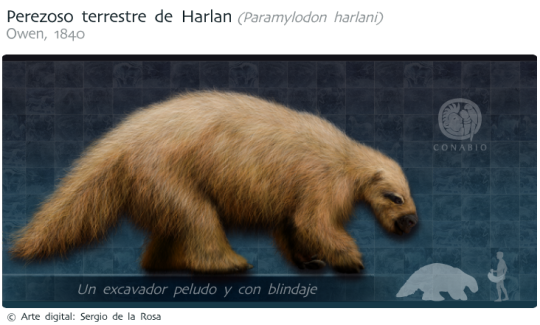
"Harlan's ground sloth" was a genus of ground sloth that evolved in North America from South American sloths that crossed the Isthmus of Panama about 5 million years ago but disappeared 10,000 years ago.

The "shrub-ox" was a bovid native to North America and a close relative of the arctic musk ox. It was one of the first bovids to reach the Americas via Bering in the early Pleistocene epoch, long before the Eurasian bison arrived.

The "Florida cave bear", a sister species of the South American spectacled bear, was one of the last species to disappear during the extinction process that occurred at the end of the Ice Age.

The "American camel" or "western camel", Camelops was a genus of camelids that evolved in North America about 5 million years ago and disappeared 10,000 years ago.
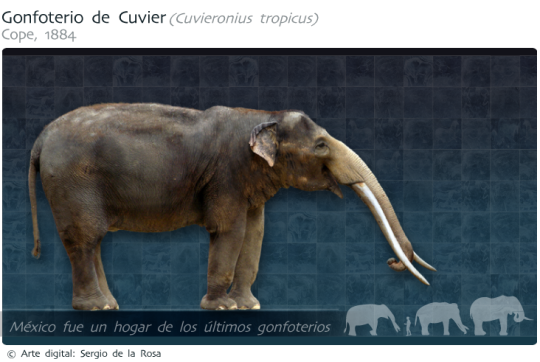
Cuvieronius is an extinct New World genus of gomphothere which ranged from southern North America to eastern South America. It became extinct approximately 12,000 years ago, following the arrival of humans to the Americas.
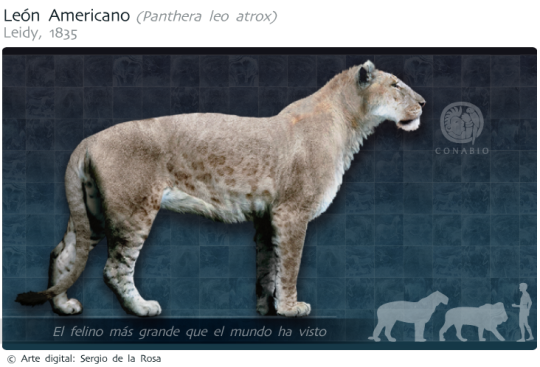
The "American Lion", not to be confused with the puma or "mountain lion", is a fossil feline that for some time caused some controversy among paleontologists since several believed that it was actually a variety of tiger or jaguar. DNA studies published in 2009 verified their true lineage: that of lions.

The "Mexican glyptodon" was one of at least 5 species of glyptodons that inhabited North America after their ancestors crossed the still-forming land bridge between South and Central America about 3.9 million years ago.

The "Great Short-Faced Bear", one of the largest bears to ever walk the earth.

Mixotoxodon was a notoungulate mammal, an animal similar to today's rhinos although it was not related to the latter. It survived and prospered during the great American exchange since it was apparently the only specimen of its kind to leave South America and take advantage of new territories when the Isthmus of Panama was formed.

Smilodon, commonly called the "Saber-toothed Tiger", was a distant relative of the cats now live on planet earth. The domestic cat is a closer cousin to the tiger, than the latter to Smilodon.
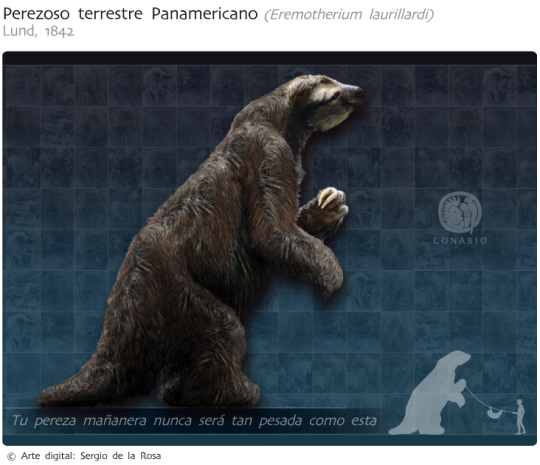
The Pan American ground sloth, a giant toothed relative of today's tree sloths, evolved in South America but with the emergence of the Isthmus of Panama, this creature took the opportunity to move to Central and North American territories.

The Columbian mammoth is an extinct species of mammoth that inhabited the Americas as far north as the Northern United States and as far south as Costa Rica.
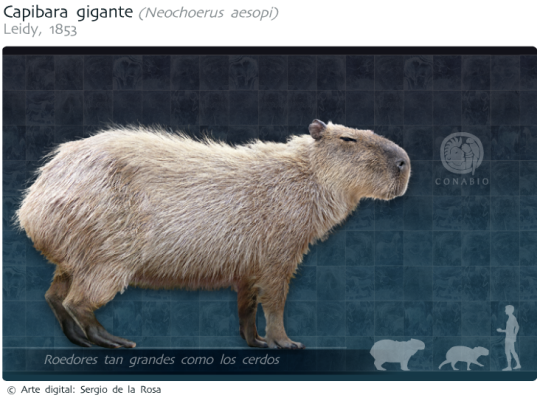
The "giant capybara" inhabited North America from about 3.6 million years ago until the end of the Pleistocene when the Hydrochoeridae family (the capybaras) became extinct from this part of the continent.
#ice age#mexico#mammoth#sloth#dire wolf#american lion#bison#capybara#smilodon#extinct species#extinction
13 notes
·
View notes
Text



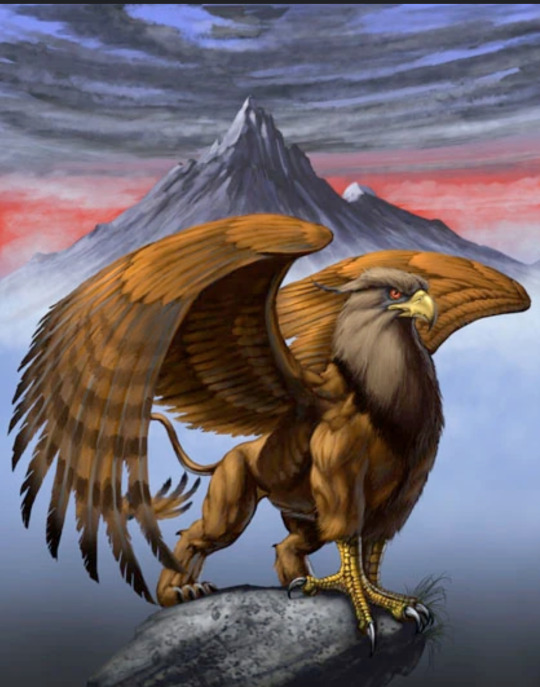


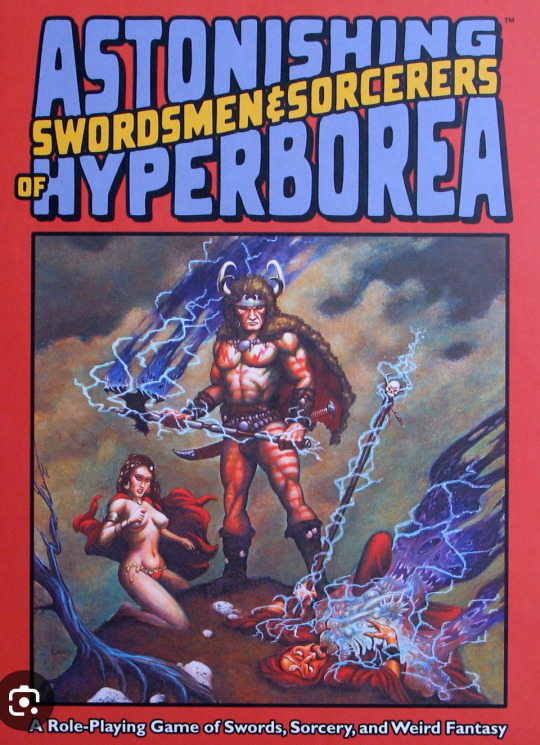


Pics:
1 & 2. Intro/description on griffins.
3 thru 6. Griffins galore!!
7 & 8. Examples of the "Hyperborea" Role Playing Games!
9. Title page to Milton's 2nd edition of "Paradise Lost."
Part 2 - Notes.
1. Griffins are majestic but, mythic beasts whose body is made up like a mashup of a lion's body & an eagle's head & wings.
2. The Hyperboreans were a mythic "people living beyond the North Wind."
Their lands were - supposedly - a northern paradise that was warm, sunny & blessed by Apollo.
In return for Apollo's blessings, the Hyperboreans founded shrines at Delos (floating isle & birthplace of Apollo) & Delphi (home of Apollo's oracle sanctuary).
3. Arismaspians were a mythic nation living in the southern foothills of the Rhipaean Mountains in northern Scythia (now the Ukrainian & Russian steppes).
They used horses for traveling, food, clothing, war & trading.
Ancient writers might have been inspired by the horse-clans of the Scythian folk.
4. John Milton was an English poet, polemicist (strong debater) & civil servant for the Commonwealth of England &, later, for Oliver Cromwell.
He created many new English words based on Greek & Latin bases.
Milton became famous for his "Areopagitica ( )," an impassioned defense of the freedoms of speech & a free press.
5. "Gryphus in Asinum Mutatus" is Latin for "how a gryphon became an ass."
Today, the sentiment is basically, "you turned treasure into garbage."
6. "Paradise Lost" is Milton's most epic poem. It was printed in blank (unrhymed) verse in 1667.
The book retells the Biblical story of Adam (red earth son) & Eve (mother of life) - in greater detail.
Also, the Fall of Lucifer (light bringer)!!
But, this book was banned - by King Charles the 2nd!! - because Milton publicly opposed the British monarchy & its Anglican Church!
7. Blarney is defined, by Irish politician John O'Connor, as "skillful flattery & really clever talk."
"Sweetened," he continued, "by humor & flavored by wit."
Originally, blarney meant "nonsense & humbug" in Irish slang.
Etymologically, Blarney means "a little field" in English.
8. Why are donkeys & asses inter- changable?
8A. Ass, "donkey" comes to us from the Anglo-Saxon word "assa," which was borrowed from the Latin "asinus."
It might originate from some Middle Eastern language ...
8B. Ass, "butt, bottom" is, of course, from the British "arse."
Somehow, the letters "r" & "s" were dropped in translation - but, only in American English!
9. The Rhipaean (windy? gusty?) Mt.s are a mythic place far northeast of the Mediterranean Sea area.
A cave on its southern face was, supposedly, from where icy Boreas (the north wind) emerged.
Map makers kept placing this lofty range further away as Eurasia became better explored - by traders.
These mythic mountains would persist on Western maps - until the dawn of the Renaissance!
1 note
·
View note
Text

Large canvas wall art American cave lion in winter
An extinct representative of felines. Lived on the territory of North America in the Pleistocene. Known as the North American cave lion.
It was very similar to modern African and Asian lions, but was slightly larger than them.

Large canvas wall art American cave lion in winter. Paleoart artwork for walls. Aesthetic wall art prehistoric lion print on canvas can be used as cottagecore art, above bed art, birthday gift, gift for husband.
This exclusive and unrepeatable painting can be purchased here:
#abovebedart#aestheticwallart#americancavelion#animalwalldecor#apartmentdecor#artprint#artworkforwalls#atrox#birthdaygift#carniwora#cavelion#cottagecoreart#couplesgift#dinosaurart#extinctanimals#farewellgift#fossil#gallerywallprints#giftforhim#giftforhusband#iceage#illustration#kitchenart#kitchenwalldecor#largecanvaswallart#leo#lion#lioninwinter#mammalls#mammothfauna
0 notes
Text
Giant sloth size

Often difficult to learn details of the life habits of animals from theirįossils. Aside from the basics of size, food choice and general mobility, it is.Jeffersonii became the official state fossil of West Virginia. In 2008, Jefferson received a final honor from his fossil, when Megalonyx Took Wistar’s suggestion, naming the fossil Megalonyx jeffersonii. Twenty-three years later, French zoologist Anselme Gaëtan Desmarest Caspar Wistar correctly identified the bonesĪs belonging to a sloth and suggested that the specimen be named in Jefferson’s (which means “giant claw”) because he thought the bones belonged to a giantĮxtinct lion. To then-Vice President Thomas Jefferson, who named the animal Megalonyx Former Revolutionary War Colonel John Stuart first discovered Megalonyxīones in a cave in present-day West Virginia in 1796.Indeed, His waysĪre higher than our ways, and hallelujah for that! Tail, huge claws, and “weak” teeth could migrate all the way into North Americaįrom South America and be so successful? In the changing world after Noah’sįlood, including the Ice Age, Megalonyx reminds us that God’s intriguingĪnd effective designs are often packaged in surprising ways. Who would have thought that big, lumbering herbivores with flat feet, a fat Unlike nearlyĪll other mammals, Megalonyx never had to worry about a chipped tooth! Part would wear out and be replaced by healthy dentin over time. Modern sloths) could keep on eating even if a tooth was damaged, since the damaged How can teeth that wear out faster be a good design? The surprising answer 4 Dentin is much softer than enamel, and wears out faster. Sloths possess simple peg-like molar (back) teeth made primarily of the materialĭentin. Which lack the hard enamel found in humans and nearly all other mammals. One of the most peculiar anatomical features of sloths is their teeth, So instead of worrying, Megalonyx could concentrate on his main task:Įating. Probably didn’t worry too often about predators. Its large size,īig claws, and ability to stand up made it look very, very big. One swipe from the arm of a Megalonyx may have been more powerful thanīut such encounters were probably rare for this gentle giant. However, they also made for a very effective defense against predators: Up to 8 inches (20 cm) long! Unlike the claws of modern lions, these “giantĬlaws” (what Megalonyx means) were mostly used to grasp and tear up branchesĪnd leaves. The arm and shoulder bones are large, and have wide wings andĮach of the three fingers on the hand was equipped with large, powerful claws, Spent time ripping down and feasting on soft leaves and fruit from trees.īending down those huge branches to reach its mouth was the job of Megalonyx’s Its massive hips gave ample area for strong muscles, while Megalonyx Massive legs, God provided Megalonyx with a thick, muscular tail (a rarityįor land mammals), which meant that Megalonyx easily balanced on a “tripod.” To give this giant ground sloth added stability and to ease the stress on its This provided good surface area for carrying weight and better balanceĪnd Megalonyx probably spent a lot of time standing in order to eat. Walked with its heel, foot, and toe bones all on the ground, just as you and You see, unlike most sloths, the hind feet of Megalonyx are what biologistsĬall “plantigrade.” That means they are built like human feet: Megalonyx And at 1,000 pounds (455 kg), this giant sloth was about Trees! Instead, it was designed for life on the ground, starting with its feet.Īt up to 10 feet (3 m) long, Megalonyx would tower At that size, this short-faced,īarrel-chested behemoth likely didn’t spend any time hanging upside down in It was about the size of an American bison. At up toġ0 feet (3 m) long, weighing 1,000 pounds (455 kg), and walking on all fours, Now Megalonyx certainly doesn’t look like a typical sloth. 2 From West Virginia to California, from Texas to North Dakota,Īnd even throughout Canada’s Northwest and Yukon territories, this sloth really In sedimentary deposits formed just prior to and during the Ice Age that occurredĪfter Noah’s Flood. Fossils of this extinct animal are found all over the continent One of the most common giant sloths known from North America is Megalonyx Giant ground sloths, and they were built for walking. Looks very different from the sloths hanging around in the zoo. Go to a natural history museum, you’re likely to see a sloth skeleton which Trees, eating leaves, and generally not moving very much (or very fast!), theyĪre nonetheless favorites at zoos. It was designed for life on the ground, starting with its feet.Īmong the living mammals, sloths are an odd group.

1 note
·
View note
Text
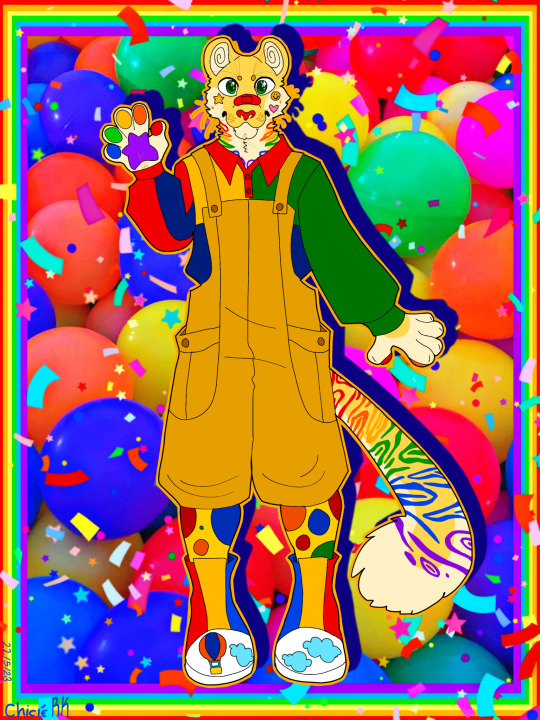
Meet Sunny The North American Cave Lion! (Yes his design is basically just my Sonic oc but they are different guys) (he/him)
Artwork and Character by me
Character: Sunny The North American Cave Lion
#kidcore#clowncore#clown#rainbowcore#kidcore fashion#my art#art#autism#clowncore fashion#furry#fursona#Paleo Fursona#extinct animal fursona#Lion furry#cave Lion furry#cave Lion#cave lion fursona#kidcore fursona
23 notes
·
View notes
Photo

Panthera leo atrox (American lion) and Smilodon californicus (California saber-tooth) skeletons on display at the George C. Page Museum.
#La Brea Tar Pits#Panthera leo atrox#Smilodon californicus#American lion#North American lion#American cave lion#North American cave lion#Cave lion#Smilodon#Sabre-tooth cat#Saber-tooth cat#Skeletons#Museum#George C. Page Museum#George C. Page Museum of La Brea Discoveries#Prehistoric#Pleistocene#Extinct#Admin Leopard's favorites
100 notes
·
View notes
Text
What if quirk users that are able to transform into extinct animals are a catalyst for bringing back said extinct animal?
Take Titanoboa for instance. If a female user can transform into her snake form, then it’s theoretically possible that she could reproduce. It wouldn’t have to be with a male Titanoboa. Some snakes have been observed to go through parthenogenesis (embryos develop without sperm fertilization) in the wild and in captivity. It was first thought snakes did this when there where no males around, but scientists have seen pit vipers undergo parthenogenesis with available males to mate with.
If this quirk user is undergoes this and gives birth while in her snake form, then she’d have baby snakes since her genes, at the time of the birth, are that of a Titanoboa.
Now, these offspring would be inbred as they’re fifty percent of her, but with all the quirks available in the realm of science, medicine, and technology, there’s a good chance some would able to take this phenomena and increase the chance of viability via genetic engineering and gene monitoring. Next thing you know, Titanoboas are reintroduced to extant animal species.
Parthenogenesis hasn’t been observed or documented occurring naturally in mammals. It’s still not off the table though! Take Gigantopithecus for example; Orangutans are their closest relatives. While it wouldn’t be a ‘pure’ Gigantopithecus, it would be a step closer to understand their DNA and recreating a full-fledge member of the species and a modern Bigfoot lookalike.
Or breading a modern lion with the American Lion (Panthera atrox). Or breading a modern bear with an extinct member of Ursidae (A South American Short Faced Bear [Arctotherium] or the Short Face Bears of North American [Arctodus]; or ones in the Ursus genus, like the Cave Bear [Ursus spelaeus] and Etruscan Bear [Ursus etruscus]; or the Steppe Brown Bear [Ursus arctos priscus] which is an extinct subspecies of the Brown Bear).
They aren’t exact DNA matches. Whole genome sequences will be different from the millions of years of evolution, but they’re quite close compared to other species and genome editing can do wonders. And the closer they are in relation (such as the Steppe Brown Bear), the more likely their offspring would be healthy and closer to the original extinct animal.
Or Mammuthus! If a female is able to shift into a Mammuthus species, of which scientists have found preserved soft tissue remains and DNA, that’s an available coupling with non-related DNA, leading to a healthy offspring.
(Let us ignore any implications of bestiality because this would be done in genetic labs due to genome engineering. And ignore all the others things that could possibly go wrong when this turns into a Jurassic Park/World situation. But it’s cool to think about!)
Fuck, I love when superpowers and science combines.
#quirk thoughts#bnha quirks#quirk science#bnha meta#bnha oc#science#I guess kinda#ignore my rambling#bnha ramblings
49 notes
·
View notes
Text
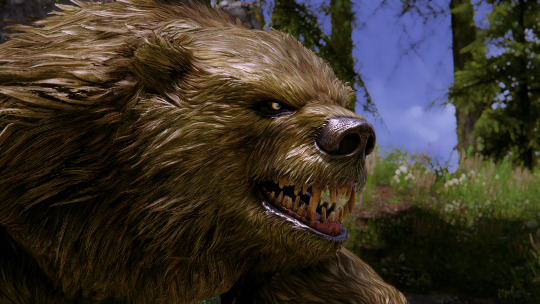
Compared to prehistoric bear species, modern bears are relatively tame. Then again, today’s bruins don’t have to carve out territory from other terrifying predators such as saber-toothed cats, packs of dire wolves, cave lions, and even massive carnivorous, cow-sized pigs that were more likely to charge you—and eat you—then run away.
However, thanks to 200+ years of forced evolution via mutation due to nuclear fallout, that may not be the case anymore.
First documented in the former US state of Alabama, but now reported primarily among the land’s more wooded northern regions, The North American Dire Bear, is an imposing yet surprisingly interesting creature. It is a fairly widespread but uncommon animal that’s survived this far by being reclusive: less than three dozen sightings are reported on average annually.
How this particular bear species came to be is unknown, but theories suggest a surprising, evolutionary history fueled by the mixed species breeding of large pre-war bear species. Its known all the Ursinae species (i.e., all bears except the giant panda and the spectacled bear) appear able to crossbreed, leading to hybrids such as the Grizzly–polar bear hybrid and the Kodiak × polar bear hybrid aka "The Grolar Bear"
Thought it is unclear as to what possible species mixing established this creature, the mark it leaved in it’s wake is well known. One of the largest and most unique of all bears that now rule America, it is differentiated from the modern brown bears and grizzles by the more distinctive "bulldog” like facial structure. Resembling a grizzly bear in appearance, the North American Dire Bear is distinguishable by its shorter snout and more robust build, earning it the nickname "Short-Faced Bear", fitting title for the immense animal as the extinct Great Short-faced bear, did once roam prehistoric America, and due to its large size was considered to be one of the biggest known terrestrial mammalian carnivores ever known.
Like other bears, they are capable of standing on their hind legs, but only to intimidate those that enter its territory. The beast is also surprisingly swift for its hulking build, and are solitary roamers who will eat pretty much anything they can find. The bear family staples of berries, leaves, roots and tubers, fish, nuts, and small animals are all eagerly eaten, but it is a craving for red meat that makes this giant bears so famous…and so dangerous. North American Dire Bears are among the most predatory of all bear species (after the polar bear), chasing after game and bowling it over with swipes from their huge paws. Even large game like bison can be taken down, killed with a decisive crunching bite to the neck or braincase, with it shorter snout aiding in allowing the creature to hold on without having to let go on occasion to breath through it’s nose while it’s mouth is full. They are also adept scavengers and kill-stealers; using their highly attuned sense of smell these bears can travel great distances in search of carrion, relying on their huge size and strength to scare off other carnivores.
Adult Males can stand 12-14 ft tall with a 4.3-meter 14 ft vertical arm reach. When walking on all fours, they stand 6 feet high at the shoulder and are tall enough to look an adult human in the eye. The largest individuals of this species are are estimated to have weighed more than 1,200 kg (2,600 lb) with the largest recorded animal ever killed was 3,200 pounds.
A male grizzly, for comparison, weighs about 600. An adult male polar bear weighs around 775 to 1,200 lbs with the largest polar bear recorded weighing 2,209 pounds (1,000 kg), according to Polar Bear International. Females weigh half as much as their male counterparts, at only or 330 to 650 lbs.
One of the most interesting aspects in their behaviors is their habit of frequently stealing game from snare traps and they have even been known to follow hunters until they make a kill, which is why many refer to them as “kill-sitter bears”. Wilderness adventurers frequently cross paths with bears but it is the Dire Bear variety that inspires the most fear and awe in their campfire stories; for if the tales are true, then some of these animals have become quite accomplished maneaters.
#Fallout 4 World Building#What is sought is most often found if it is truly sought: World Information#Fallout#Fallout 4#Fallout AU#fo4
5 notes
·
View notes
Text
Cap 168 : Paleoindios en Islas del Pacífico de Canadá y Estados Unidos.
.
Para la Teoría de la Llegada Costera de los Paleoindios desde Beringia hasta Norte América es vital estudiar los Yacimientos Arqueológicos en Islas del Océano Pacífico de Canadá y Estados Unidos.
.
Siguiente Mapa : Ves las Ciudadades de Los Angeles y San Diego en California y las Islas del Canal a la Izquierda arriba = Santa Rosa a la izquierda y Santa Cruz a la derecha.
.
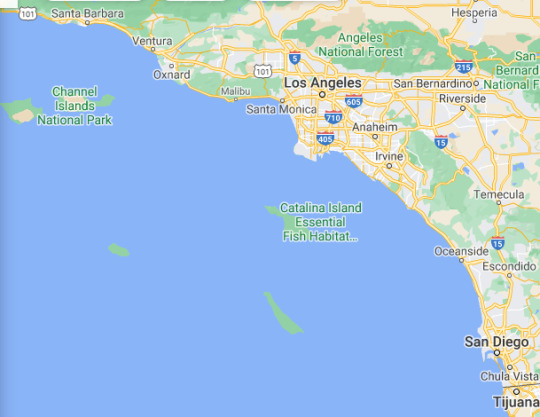
.
En el siguiente Mapa ves a toda California, Tijuana queda en México. Las Islas del Canal son las muy cercanas a la Ciudad de Los Angeles.
.
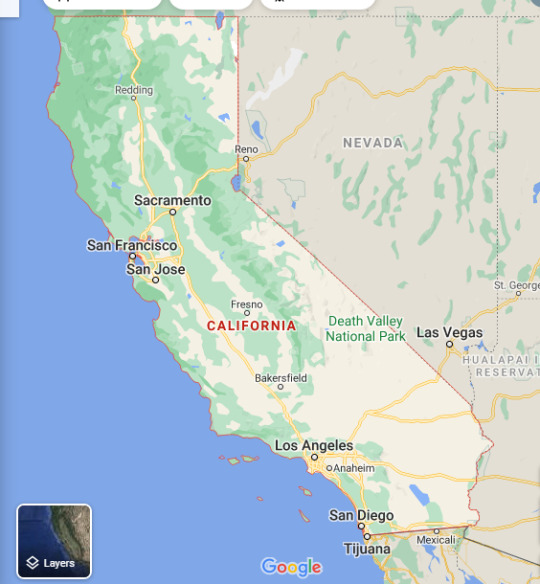
Aunque no es la Prueba Reina, ni es la Seguridad definitiva y total, si es cierto que se acumulan Evidencias en las Islas del Pacífico Norte, frente a Canada y Estados Unidos de que los Paleoindios eran fuertes inteligentes navegantes en Botes y que estaban acostumbrados a comer productos Marinos como Peces, Moluscos, Mamíferos Marinos, etc ..
.
Las Islas del Canal se pueden divisar desde las Montañas de Santa Bárbara, California. Los Paleoindios tenían que ser buenos Navegantes en Botes para recorrer los 10 Kilómetros de Mar que separaban al Continente de las Islas en ese Tiempo de 12,000 Años antes del Presente.
.
*******************************
.
Abstract
Three archaeological sites on California’s Channel Islands show that Paleoindians relied heavily on marine resources. The Paleocoastal sites, dated between ~12,200 and 11,200 years ago, contain numerous stemmed projectile points and crescents associated with a variety of marine and aquatic faunal remains.
At site CA-SRI-512 on Santa Rosa Island, Paleocoastal peoples used such tools to capture geese, cormorants, and other birds, along with marine mammals and finfish. At Cardwell Bluffs on San Miguel Island, Paleocoastal peoples collected local chert cobbles, worked them into bifaces and projectile points, and discarded thousands of marine shells.
With bifacial technologies similar to those seen in Western Pluvial Lakes Tradition assemblages of western North America, the sites provide evidence for seafaring and island colonization by Paleoindians with a diversified maritime economy.
.
Fuente : Revisa Science
Paleoindian Seafaring, Maritime Technologies, and Coastal Foraging on California’s Channel Islands
.
https://science.sciencemag.org/content/331/6021/1181
.
*******************************
-
El Corredor del Río MacKenzie entre las Capas de Hielo Laurentida y Cordillerana pudo demorarse mucho en ser abierto y transitable. Y es posible que los Paleoindios ya estuvieran en Estados Undios por Vía Marítima, es decir navegando en Botes.
.
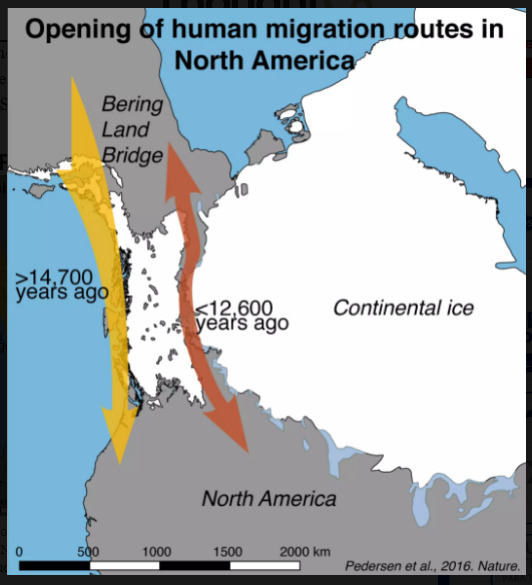
.
Fuente : Is the Ice-Free Corridor an Early Pathway into Americas? - By K. Kris Hirst
Updated July, 2019
https://www.thoughtco.com/ice-free-corridor-clovis-pathway-171386
.
*******************************
.
Sedimentos extraídos con Taladro como un Tubo de la Isla Sanak en Archipiélago de las Aleutas de Alaska muestran que había un Corredor Marino libre para los Paleoindios. El Siguiente Mapa muestra donde queda la Isla Sanak en la Geografía de Hoy, las Investigaciones dan prueba de no estar cubierta de Hielos antes de que se abriera el Corredor terrestre entre las Capas de Hielo Laurentida y Cordillerana. Y de que pudiera haber dado Alimentos para la Vida Humana.
.
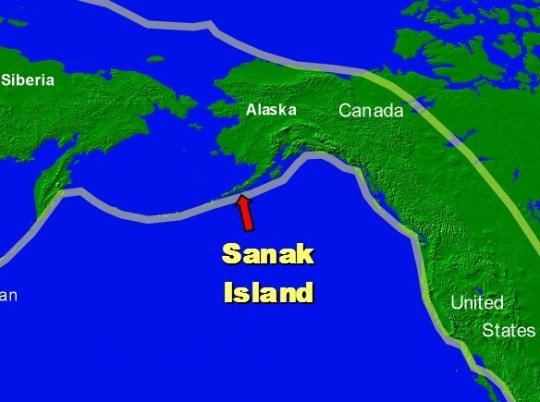
.
Siguiente Mapa : Como era la Isla Sanak integrada al Continente Beringia. Cuando se abrió el Corredor ( Corridor ), Pasadizo o Brecha ya habían llegado los Paleoindios a British Columbia y a Estados Unidos. Los Científicos dudan que el Corredor proporcionara Alimentos a Animales y Hombres en sus Primeros Cientos de Años libre de Hielo.
.

.
Sanak Island lies around the midpoint of the Aleutian Archipelago extending off Alaska. It is 15 miles long by 6 miles wide and is capped by a single volcano called Sanak Peak. The Aleutians would have been the highest point on the Beringian landmass. The analysis of pollen from sagebrush, heather, willow and grasses, as well as radiocarbon-dated deep water sediments, from the bottom of 3 lakes on Sanak indicate that the island and its now-submerged coastal plains (and therefore the northern part of the Pacific coastal route) were free of ice by around 17,000 years ago.
Th Island is capped by a single volcano called Sanak Peak. The Aleutians would have been the highest point on the Beringian landmass.
.
New evidence suggests sea-faring Paleo-Indians were colonising America 2,000 years before Ice Free Corridor opened --- by Lee Rimmer
.
https://www.abroadintheyard.com/evidence-suggests-seafaring-paleoindians-colonising-americas-before-ice-free-corridor-opened/
.
*******************************
.
Fuente : Revista Nature, ver link abajo
Humanos habitando las Islas del Canal de California hace 13,000 Años y cambiando la Fauna.
.
California’s Channel Islands (CCI) are an ideal system to refine our diagnostic toolkit due to the well-studied geologic and human histories and communities of iconic endemic fauna. The CCI consist of eight islands that are currently located approximately 20–100 km from the California coastline.
The size of the islands and their distance to the mainland has shifted with past glacial-interglacial cycles, but they were never connected by a land or ice bridge during the Quaternary .
The CCI are split into two north–south island groupings with distinct geologic histories: the northern islands (Santa Rosa, San Miguel, Santa Cruz, Anacapa) were joined as a single superisland, Santarosae, as recently as 10,000 years ago, whereas the southern islands have always been more isolated.
.
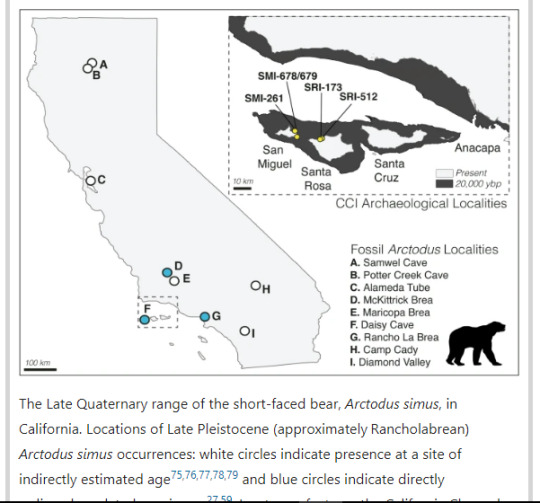
.
Humans colonized Santarosae ~ 13,000 years ago, although there are hints of a possible earlier human presence. The island’s more than 700 archaeological sites document substantial anthropogenic influences on the ecology of the islands from the Late Pleistocene to the present, including the introduction of taxa previously considered to be native endemic lineages. Daisy Cave (CA-SMI-261), a well-studied and finely stratified archaeological and paleontological site on San Miguel Island, has yielded a diverse assemblage of faunal remains that provide critical insights about the relationships between Indigenous peoples and the endemic fauna of the CCI.
.
Biogeographic problem-solving reveals the Late Pleistocene translocation of a short-faced bear to the California Channel Islands.
.
https://www.nature.com/articles/s41598-020-71572-z
.
*******************************
.
The three island camps, which are between about 11,000 and 12,000 years old, show that some early Americans were well adapted to coastal living.
........
Because the Channel Islands would have lain some 10 kilometres off the California coast at the time, the hunters must have reached them by boat, Rick says. Once they found the islands, which are visible from present-day Santa Barbara, the mariners would have found ample food and few predators. "They would have found an amazing suite of resources — massive amounts of seabirds, seals and sea lions" not found on the mainland, he says. "In my view it would have seemed like a paradise."
The archaeologists surmise that the people who lived at the Channel Island sites were adept at making a living from the sea, and were not from the interior of North America. The tools found on the Channel Islands are a better match to tools attributed to the Western Pluvial Lakes Tradition in the Pacific Northwest than to the inland Clovis culture, which, also, had disappeared by around 12,000 years ago. "What it tells us is that these weren't people who came from the continental interior and stumbled onto the coast," says Rick.
........................
Ted Goebel, an archaeologist at Texas A&M University in College Station, says the stemmed stone points found on the Channel Islands resemble those found in Kamchatka, Russia, dating from 1,000 years earlier,
March 2011
Seafront property attracts ancient Californians
Ewen Callaway
Nature (2011)
.
https://www.nature.com/articles/news.2011.135
.
.
*******************************
.
Hay varios Yacimientos Arqueológicos en las Islas del Norte del Canal de California, muy cercanas a la Ciudad de Los Angeles. Estos se detallan en el Link al Artículo mas abajo.
Aquí están sus Nombres en este Mapa. Estas Islas estaban Unidas hace 14,000 Años y a esa gran Isla se le llama Santarosae, para distinguirla de la Santa Rosa actual.
Algunos hallazgos dan Cronologías de 13,500 Años antes del Presente, y varios intermedios hasta 11,000 AP.
Estos Yacimientos demuestran que los Paleoindios dominaban la Navegación en Botes, la Subsistencia de Animales Marinos como Peces, Moluscos y Mamíferos Marinos, también capturaban Aves Marinas y sus Huevos. Y se demuestra que perfectamente se podían desplazar por la Costa hasta llegar al antiquísimo Yacimiento Paleoindio de Monte Verde en Chile. El que destruyó la Hipótesis del “Clovis Primero” por su brutal Antiguedad.
Como estas Islas de California prometen tanto, entonces los Científicos están empezando a hacer Arqueología submarina con Vehículos no tripulados a Profundidad y con muchos Instrumentos, tratando de no arriesgar Humanos en una Labor muy pesada, demorada y ardua para hallar yacimientos sumergidos bajo mas de 100 mts que subió el Nivel del Mar desde hace 14,000 Años hasta el Presente.
Los mejores Hallazgos están por hacerse a mas de 100 mts de Profundidad pues ahí deber estar los Asentamientos Pesqueros Paleoindios. .
.
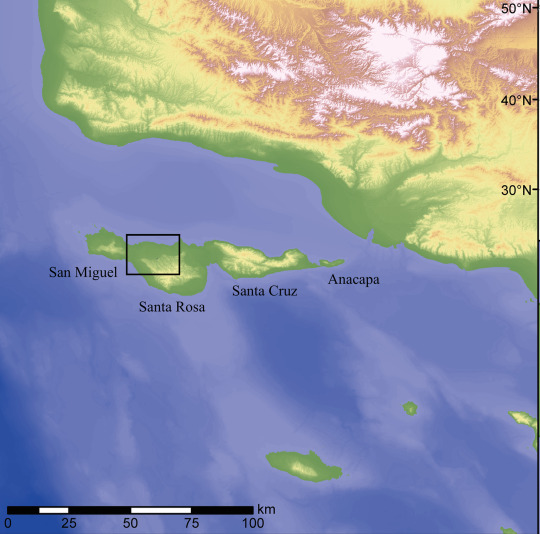
.
Site setting, stratigraphy, and dating
Today the NCI—consisting of Anacapa, Santa Cruz, Santa Rosa, and San Miguel islands—are located between 20 and 44 km from the adjacent mainland coast (Fig 1). Near the end of the Last Glacial Maximum (ca 20,000 cal BP), however, the islands were united into a single ~125 km long island known as Santarosae [12], the eastern end of which was as little as 6–8 km from the mainland.
The latest reconstructions of Santarosae’s paleogeography suggest that rising post-glacial sea level reduced the landmass by as much as 70–75 percent, causing the NCI to separate between about 11,000 and 9,000 years ago. Then and now, the NCI had a relatively impoverished terrestrial fauna, a fairly diverse and productive flora, and a wealth of edible marine resources, from seaweeds to marine mammals, shellfish, fish, and seabirds.
.
Maritime Paleoindian technology, subsistence, and ecology at an ~11,700 year old Paleocoastal site on California’s Northern Channel Islands, USA
.
https://journals.plos.org/plosone/article?id=10.1371/journal.pone.0238866
.
*******************************
.
.
1 note
·
View note
Text

William Henry Pratt (23 November 1887 – 2 February 1969), better known by his stage name Boris Karloff was an English actor who was primarily known for his roles in horror films. He portrayed Frankenstein's monster in Frankenstein (1931), Bride of Frankenstein (1935) and Son of Frankenstein (1939). He also appeared as Imhotep in The Mummy (1932).
In non-horror roles, he is best known to modern audiences for narrating and as the voice of the Grinch in the animated television special of Dr. Seuss' How the Grinch Stole Christmas! (1966). For his contribution to film and television, Karloff was awarded two stars on the Hollywood Walk of Fame.
Karloff was born William Henry Pratt on 23 November 1887,[2] at 36 Forest Hill Road, Dulwich, Surrey (now London), England. His parents were Edward John Pratt, Jr. and Eliza Sarah Millard. His brother, Sir John Thomas Pratt, was a British diplomat. Edward John Pratt, Jr. was an Anglo-Indian, from a British father and Indian mother, while Karloff's mother also had some Indian ancestry, thus Karloff had a relatively dark complexion that differed from his peers at the time. His mother's maternal aunt was Anna Leonowens, whose tales about life in the royal court of Siam (now Thailand) were the basis of the musical The King and I. Pratt was bow-legged, had a lisp, and stuttered as a young boy.[7] He learned how to manage his stutter, but not his lisp, which was noticeable throughout his career in the film industry.
Pratt spent his childhood years in Enfield, in the County of Middlesex. He was the youngest of nine children, and following his mother's death was brought up by his elder siblings. He received his early education at Enfield Grammar School, and later at the public schools of Uppingham School and Merchant Taylors' School. After this, he attended King's College London where he took studies aimed at a career with the British Government's Consular Service. However, in 1909, he left university without graduating and drifted, departing England for Canada, where he worked as a farm labourer and did various odd itinerant jobs until happening upon acting.
Pratt began appearing in theatrical performances in Canada, and during this period he chose Boris Karloff as his stage name. Some have theorised that he took the stage name from a mad scientist character in the novel The Drums of Jeopardy called "Boris Karlov". However, the novel was not published until 1920, at least eight years after Karloff had been using the name on stage and in silent films, opening the possibility that the Karlov character might have been named after Karloff after the novel's author noticed it in a cast listing and liked the sound of it rather than simply being a coincidence. Warner Oland played "Boris Karlov" in a film version in 1931. Another possible influence was thought to be a character in the Edgar Rice Burroughs fantasy novel H. R. H. The Rider which features a "Prince Boris of Karlova", but as the novel was not published until 1915, the influence may be backward, that Burroughs saw Karloff in a play and adapted the name for the character. Karloff always claimed he chose the first name "Boris" because it sounded foreign and exotic, and that "Karloff" was a family name (from Karlov—in Cyrillic, Карлов—a name found in several Slavic countries, including Russia, Ukraine and Bulgaria).
Karloff's daughter, Sara, publicly denied any knowledge of Slavic forebears, "Karloff" or otherwise. One reason for the name change was to prevent embarrassment to his family. Whether or not his brothers (all dignified members of the British Foreign Service) actually considered young William the "black sheep of the family" for having become an actor, Karloff apparently worried they felt that way. He did not reunite with his family until he returned to Britain to make The Ghoul (1933), extremely worried that his siblings would disapprove of his new, macabre claim to world fame. Instead, his brothers jostled for position around him and happily posed for publicity photographs. After the photo was taken, Karloff's brothers immediately started asking about getting a copy of their own. The story of the photo became one of Karloff's favorites.
Karloff joined the Jeanne Russell Company in 1911 and performed in towns like Kamloops (British Columbia) and Prince Albert (Saskatchewan). After the devastating tornado in Regina on 30 June 1912, Karloff and other performers helped with clean-up efforts. He later took a job as a railway baggage handler and joined the Harry St. Clair Co. that performed in Minot, North Dakota, for a year in an opera house above a hardware store.
Whilst he was trying to establish his acting career, Karloff had to perform years of manual labour in Canada and the U.S. in order to make ends meet. He was left with back problems from which he suffered for the rest of his life. Because of his health, he did not enlist in World War I.
During this period, Karloff worked in various theatrical stock companies across the U.S. to hone his acting skills. Some acting companies mentioned were the Harry St. Clair Players and the Billie Bennett Touring Company. By early 1918 he was working with the Maud Amber Players in Vallejo, California, but because of the Spanish Flu outbreak in the San Francisco area and the fear of infection, the troupe was disbanded. He was able to find work with the Haggerty Repertory for a while (according to the 1973 obituary of Joseph Paul Haggerty, he and Boris Karloff remained lifelong friends). According to Karloff, in his first film he appeared as an extra in a crowd scene for a Frank Borzage picture at Universal for which he received $5; the title of this film has never been traced.
Once Karloff arrived in Hollywood, he made dozens of silent films, but this work was sporadic, and he often had to take up manual labour such as digging ditches or delivering construction plaster to earn a living.
His first on screen role was in a film serial, The Lightning Raider (1919) with Pearl White. He was in another serial, The Masked Rider (1919), the first of his appearances to survive.
Karloff could also be seen in His Majesty, the American (1919) with Douglas Fairbanks, The Prince and Betty (1919), The Deadlier Sex (1920), and The Courage of Marge O'Doone (1920). He played an Indian in The Last of the Mohicans (1920) and he would often be cast as an Arab or Indian in his early films.
Karloff's first major role came in a film serial, The Hope Diamond Mystery (1920). He was Indian in Without Benefit of Clergy (1921) and an Arab in Cheated Hearts (1921) and villainous in The Cave Girl (1921). He was a maharajah in The Man from Downing Street (1922), a Nabob in The Infidel (1922) and had roles in The Altar Stairs (1922), Omar the Tentmaker (1922) (as an Imam), The Woman Conquers (1922), The Gentleman from America (1923), The Prisoner (1923) and the serial Riders of the Plains (1923).
Karloff did a Western, The Hellion (1923), and a drama, Dynamite Dan (1924). He could be seen in Parisian Nights (1925), Forbidden Cargo (1925), The Prairie Wife (1925) and the serial Perils of the Wild (1925).
Karloff went back to bit part status in Never the Twain Shall Meet (1925) directed by Maurice Tourneur but he had a good support role in Lady Robinhood (1925).
Karloff went on to be in The Greater Glory (1926), Her Honor, the Governor (1926), The Bells (1926) (as a mesmerist), The Nickel-Hopper (1926), The Golden Web (1926), The Eagle of the Sea (1926), Flames (1926), Old Ironsides (1926), Flaming Fury (1926), Valencia (1926), The Man in the Saddle (1926), Tarzan and the Golden Lion (1927) (as an African), Let It Rain (1927), The Meddlin' Stranger (1927), The Princess from Hoboken (1927), The Phantom Buster (1927), and Soft Cushions (1927).
Karloff had roles in Two Arabian Knights (1927), The Love Mart (1927), The Vanishing Rider (1928) (a serial), Burning the Wind (1928), Vultures of the Sea (1928), and The Little Wild Girl (1928).
He was in The Devil's Chaplain (1929), The Fatal Warning (1929) for Richard Thorpe, The Phantom of the North (1929), Two Sisters (1929), Anne Against the World (1929), Behind That Curtain (1929), and The King of the Kongo (1929), a serial directed by Thorpe.
Karloff had an uncredited bit part in The Unholy Night (1930) directed by Lionel Barrymore, and bigger parts in The Bad One (1930),The Sea Bat (1930) (directed by Barrymore), and The Utah Kid (1930) directed by Thorpe.
A film which brought Karloff recognition was The Criminal Code (1931), a prison drama directed by Howard Hawks in which he reprised a dramatic part he had played on stage. In the same period, Karloff had a small role as a mob boss in Hawks' gangster film Scarface, but the film was not released until 1932 because of difficult censorship issues.
He did another serial for Thorpe, King of the Wild (1931), then had support parts in Cracked Nuts (1931), Young Donovan's Kid (1931), Smart Money (1931), The Public Defender (1931), I Like Your Nerve (1931), and Graft (1931).
Another significant role in the autumn of 1931 saw Karloff play a key supporting part as an unethical newspaper reporter in Five Star Final, a film about tabloid journalism which was nominated for the Academy Award for Best Picture.
He could also be seen in The Yellow Ticket (1931) The Mad Genius (1931), The Guilty Generation (1931) and Tonight or Never (1931).
Karloff acted in eighty movies before being found by James Whale and cast in Frankenstein (1931). Karloff's role as Frankenstein's monster was physically demanding – it necessitated a bulky costume with four-inch platform boots – but the costume and extensive makeup produced a lasting image. The costume was a job in itself for Karloff with the shoes weighing 11 pounds (5.0 kg) each.[13] Universal Studios quickly copyrighted the makeup design for the Frankenstein monster that Jack P. Pierce had created.
It took a while for Karloff's stardom to be established with the public – he had small roles in Behind the Mask (1932), Business and Pleasure (1932) and The Miracle Man (1932).
As receipts for Frankenstein and Scarface flooded in, Universal gave Karloff third billing in Night World (1932), with Lew Ayres, Mae Clarke and George Raft.
Karloff was reunited with Whale at Universal for The Old Dark House (1932), a horror movie based on the novel Benighted by J.B. Priestley, in which he finally enjoyed top billing above Melvyn Douglas, Charles Laughton, Raymond Massey and Gloria Stuart. He was loaned to MGM to play the titular role in The Mask of Fu Manchu (also 1932), for which he gained top billing.
Back at Universal, he was cast as Imhotep who is revived in The Mummy (1932). It was as successful at the box-office as the other two films and Karloff was now established as a star of horror films.
Karloff returned to England to star in The Ghoul (1933), then made a non-horror film for John Ford, The Lost Patrol (1934), where his performance was highly acclaimed.
Karloff was third billed in the Twentieth Century Pictures historical film The House of Rothschild (1934) with George Arliss, which was highly popular.
Horror, however, had now become Karloff's primary genre, and he gave a string of lauded performances in Universal's horror films, including several with Bela Lugosi, his main rival as heir to Lon Chaney's status as the leading horror film star. While the long-standing, creative partnership between Karloff and Lugosi never led to a close friendship, it produced some of the actors' most revered and enduring productions, beginning with The Black Cat (1934) and continuing with Gift of Gab (1934), in which both had cameos. Karloff reprised the role of Frankenstein's monster in Bride of Frankenstein (1935) for James Whale. Then he and Lugosi were reunited for The Raven (1935).
For Columbia, Karloff made The Black Room (1935) then he returned to Universal for The Invisible Ray (1936) with Lugosi, more a science fiction film. Karloff was then cast in a Warner Bros. horror film, The Walking Dead (1936).
Because the Motion Picture Production Code (known as the Hays Code) began to be seriously enforced in 1934, horror films suffered a decline in the second half of the 1930s. Karloff worked in other genres, making two films in Britain, Juggernaut (1936) and The Man Who Changed His Mind (1936).
He returned to Hollywood to play a supporting role in Charlie Chan at the Opera (1936) then did a science fiction film, Night Key (1937).
At Warners, he did two films with John Farrow, playing a Chinese warlord in West of Shanghai (1937) and a murder suspect in The Invisible Menace (1938).
Karloff went to Monogram to play the title role of a Chinese detective in Mr. Wong, Detective (1938), which led to a series. Karloff's portrayal of the character is an example of Hollywood's use of yellowface and its portrayal of East Asians in the earlier half of the 20th century. He had another heroic role in Devil's Island (1939).
Universal found reissuing Dracula and Frankenstein led to success at the box-office and began to produce horror films again starting with Son of Frankenstein (1939). Karloff reprised his role, with Lugosi co starring as Ygor and Basil Rathbone as Frankenstein.
After The Mystery of Mr. Wong (1939) and Mr. Wong in Chinatown (1939) he signed a three-picture deal with Columbia, starting with The Man They Could Not Hang (1939). Karloff returned to Universal to make Tower of London (1939) with Rathbone, playing the murderous henchman of King Richard III.
Karloff made a fourth Mr Wong film at Monogram The Fatal Hour (1940). At Warners he was in British Intelligence (1940), then he went to Universal to do Black Friday (1940) with Lugosi.
Karloff's second and third films for Columbia were The Man with Nine Lives (1940) and Before I Hang (1940). In between he did a fifth and final Mr Wong film, Doomed to Die (1940).
Karloff appeared at a celebrity baseball game as Frankenstein's monster in 1940, hitting a gag home run and making catcher Buster Keaton fall into an acrobatic dead faint as the monster stomped into home plate.
Karloff finished a six picture commitment with Monogram with The Ape (1940). He and Lugosi appeared in a comedy at RKO, You'll Find Out (1941), then he went to Columbia for The Devil Commands (1941) and The Boogie Man Will Get You (1941).
An enthusiastic performer, he returned to the Broadway stage in the original production of Arsenic and Old Lace in 1941, in which he played a homicidal gangster enraged to be frequently mistaken for Karloff. Frank Capra cast Raymond Massey in the 1944 film, which was shot in 1941, while Karloff was still appearing in the role on Broadway. The play's producers allowed the film to be made conditionally: it was not to be released until the production closed. (Karloff reprised his role on television in the anthology series The Best of Broadway (1955), and with Tony Randall and Tom Bosley in a 1962 production on the Hallmark Hall of Fame. He also starred in a radio adaptation produced by Screen Guild Theatre in 1946.)
In 1944, he underwent a spinal operation to relieve a chronic arthritic condition.
Karloff returned to film roles in The Climax (1944), an unsuccessful attempt to repeat the success of Phantom of the Opera (1943). More liked was House of Frankenstein (1944), where Karloff played the villainous Dr. Niemann and the monster was played by Glenn Strange.
Karloff made three films for producer Val Lewton at RKO: The Body Snatcher (1945), his last teaming with Lugosi, Isle of the Dead (1945) and Bedlam (1946).
In a 1946 interview with Louis Berg of the Los Angeles Times, Karloff discussed his arrangement with RKO, working with Lewton and his reasons for leaving Universal. Karloff left Universal because he thought the Frankenstein franchise had run its course; the entries in the series after Son of Frankenstein were B-pictures. Berg wrote that the last installment in which Karloff appeared—House of Frankenstein—was what he called a " 'monster clambake,' with everything thrown in—Frankenstein, Dracula, a hunchback and a 'man-beast' that howled in the night. It was too much. Karloff thought it was ridiculous and said so." Berg explained that the actor had "great love and respect for" Lewton, who was "the man who rescued him from the living dead and restored, so to speak, his soul."
Horror films experienced a decline in popularity after the war, and Karloff found himself working in other genres.
For the Danny Kaye comedy, The Secret Life of Walter Mitty (1947), Karloff appeared in a brief but starring role as Dr. Hugo Hollingshead, a psychiatrist. Director Norman Z. McLeod shot a sequence with Karloff in the Frankenstein monster make-up, but it was deleted from the finished film.
Karloff appeared in a film noir, Lured (1947), and as an Indian in Unconquered (1947). He had support roles in Dick Tracy Meets Gruesome (1947), Tap Roots (1948), and Abbott and Costello Meet the Killer, Boris Karloff.
During this period, Karloff was a frequent guest on radio programmes, whether it was starring in Arch Oboler's Chicago-based Lights Out productions (including the episode "Cat Wife") or spoofing his horror image with Fred Allen or Jack Benny. In 1949, he was the host and star of Starring Boris Karloff, a radio and television anthology series for the ABC broadcasting network.
He appeared as the villainous Captain Hook in Peter Pan in a 1950 stage musical adaptation which also featured Jean Arthur.
Karloff returned to horror films with The Strange Door (1951) and The Black Castle (1952).
He was nominated for a Tony Award for his work opposite Julie Harris in The Lark, by the French playwright Jean Anouilh, about Joan of Arc, which was reprised on Hallmark Hall of Fame.
During the 1950s, he appeared on British television in the series Colonel March of Scotland Yard, in which he portrayed John Dickson Carr's fictional detective Colonel March, who was known for solving apparently impossible crimes. Christopher Lee appeared alongside Karloff in the episode "At Night, All Cats are Grey" broadcast in 1955.[17] A little later, Karloff co-starred with Lee in the film Corridors of Blood (1958).
Karloff appeared in Abbott and Costello Meet Dr. Jekyll and Mr. Hyde (1952) and visited Italy for The Island Monster (1954) and India for Sabaka (1954).
Karloff, along with H. V. Kaltenborn, was a regular panelist on the NBC game show, Who Said That? which aired between 1948 and 1955. Later, as a guest on NBC's The Gisele MacKenzie Show, Karloff sang "Those Were the Good Old Days" from Damn Yankees while Gisele MacKenzie performed the solo, "Give Me the Simple Life". On The Red Skelton Show, Karloff guest starred along with actor Vincent Price in a parody of Frankenstein, with Red Skelton as "Klem Kadiddle Monster". He served as host and frequent star of the anthology series The Veil (1958) which was never broadcast due to financial problems at the producing studio; the complete series was rediscovered in the 1990s.
Karloff made some horror films in the late 1950s: Voodoo Island (1957), The Haunted Strangler (1958), Frankenstein 1970 (1958) (as the Baron), and Corridors of Blood (1958). In the "mad scientist" role in Frankenstein 1970 as Baron Victor von Frankenstein II, the grandson of the original creator. In the finale, it is revealed that the crippled Baron has given his own face to the monster. Karloff donned the monster make-up for the last time in 1962 for a Halloween episode of the TV series Route 66, which also featured Peter Lorre and Lon Chaney, Jr.
During this period, he hosted and acted in a number of television series, including Thriller and Out of This World.
Karloff appeared in Black Sabbath (1963) directed by Mario Bava. He made The Raven (1963) for Roger Corman and American International Pictures (AIP). Corman used Karloff in The Terror (1963) playing a baron who murdered his wife. He made a cameo in AIP's Bikini Beach (1964) and had a bigger role in that studio's The Comedy of Terrors (1964), directed by Jacques Tourneur and Die, Monster, Die! (1965). British actress Suzan Farmer, who played his daughter in the film, later recalled Karloff was aloof during production "and wasn’t the charming personality people perceived him to be".
In 1966, Karloff also appeared with Robert Vaughn and Stefanie Powers in the spy series The Girl from U.N.C.L.E., in the episode "The Mother Muffin Affair," Karloff performed in drag as the titular character.
That same year, he also played an Indian Maharajah on the installment of the adventure series The Wild Wild West titled "The Night of the Golden Cobra".
In 1967, he played an eccentric Spanish professor who believes himself to be Don Quixote in a whimsical episode of I Spy titled "Mainly on the Plains".
Karloff's last film for AIP was The Ghost in the Invisible Bikini (1967).
In the mid-1960s, he enjoyed a late-career surge in the United States when he narrated the made-for-television animated film of Dr. Seuss' How the Grinch Stole Christmas, and also provided the voice of the Grinch, although the song "You're a Mean One, Mr. Grinch" was sung by the American voice actor Thurl Ravenscroft. The film was first broadcast on CBS-TV in 1966. Karloff later received a Grammy Award for "Best Recording For Children" after the recording was commercially released. Because Ravenscroft (who never met Karloff in the course of their work on the show) was uncredited for his contribution to How the Grinch Stole Christmas!, his performance of the song was often mistakenly attributed to Karloff.
He appeared in Mad Monster Party? (1967) and starred in the second feature film of the British director Michael Reeves,The Sorcerers (1966).
Karloff starred in Targets (1968), a film directed by Peter Bogdanovich, featuring two separate stories that converge into one. In one, a disturbed young man kills his family, then embarks on a killing spree. In the other, a famous horror-film actor contemplates then confirms his retirement, agreeing to one last appearance at a drive-in cinema. Karloff starred as the retired horror film actor, Byron Orlok, a thinly disguised version of himself; Orlok was facing an end of life crisis, which he resolved through a confrontation with the gunman at the drive-in cinema.
Around the same time, he played occult expert Professor Marsh in a British production titled The Crimson Cult (Curse of the Crimson Altar, also 1968), which was the last Karloff film to be released during his lifetime.
He ended his career by appearing in four low-budget Mexican horror films: Isle of the Snake People, The Incredible Invasion, Fear Chamber and House of Evil. This was a package deal with Mexican producer Luis Enrique Vergara. Karloff's scenes were directed by Jack Hill and shot back-to-back in Los Angeles in the spring of 1968. The films were then completed in Mexico. All four were released posthumously, with the last, The Incredible Invasion, not released until 1971, two years after Karloff's death. Cauldron of Blood, shot in Spain in 1967 and co-starring Viveca Lindfors, was also released after Karloff's death.
While shooting his final films, Karloff suffered from emphysema. Only half of one lung was still functioning and he required oxygen between takes.
He recorded the title role of Shakespeare's Cymbeline for the Shakespeare Recording Society (Caedmon Audio). The recording was originally released in 1962. A download of his performance is available from audible.com. He also recorded the narration for Sergei Prokofiev's Peter and the Wolf with the Vienna State Opera Orchestra under Mario Rossi.
Records he made for the children's market included Three Little Pigs and Other Fairy Stories, Tales of the Frightened (volume 1 and 2), Rudyard Kipling's Just So Stories and, with Cyril Ritchard and Celeste Holm, Mother Goose Nursery Rhymes, and Lewis Carroll's The Hunting of the Snark.
Karloff was credited for editing several horror anthologies, commencing with Tales of Terror (Cleveland and NY: World Publishing Co, 1943) (compiled with the help of Edmond Speare). This wartime-published anthology went through at least five printings to September 1945. It has been reprinted recently (Orange NJ: Idea Men, 2007). Karloff's name was also attached to And the Darkness Falls (Cleveland and NY: World Publishing Co, 1946); and The Boris Karloff Horror Anthology (London: Souvenir Press, 1965; simultaneous publication in Canada - Toronto: The Ryerson Press; US pbk reprint NY: Avon Books, 1965 retitled as Boris Karloff's Favourite Horror Stories; UK pbk reprints London: Corgi, 1969 and London: Everest, 1975, both under the original title), though it is less clear whether Karloff himself actually edited these.
Tales of the Frightened (Belmont Books, 1963), though based on the recordings by Karloff of the same title, and featuring his image on the book cover, contained stories written by Michael Avallone; the second volume, More Tales of the Frightened, contained stories authored by Robert Lory. Both Avallone and Lory worked closely with Canadian editor and book packager Lyle Kenyon Engel, who also ghost-edited a horror story anthology for horror film star Basil Rathbone.
Beginning in 1940, Karloff dressed as Father Christmas every Christmas to hand out presents to physically disabled children in a Baltimore hospital.
He never legally changed his name to "Boris Karloff." He signed official documents "William H. Pratt, a.k.a. Boris Karloff."
He was a charter member of the Screen Actors Guild, and he was especially outspoken due to the long hours he spent in makeup while playing Frankenstein's Monster.
He married six times and had one child, daughter Sara Karloff, by fifth wife Dorothy Stine. His final marriage was in 1946 right after his fifth divorce. At the time of his daughter's birth, he was filming Son of Frankenstein and reportedly rushed from the film set to the hospital while still in full makeup.
He was an early member of the Hollywood Cricket Club.
Upon returning to England in 1959, his address was 43 Cadogan Square, London. In 1966, he bought 25 Campden House (in 29 Sheffield Terrace), Kensington W8, and 'Roundabout Cottage' in the Hampshire village of Bramshott. A longtime heavy smoker, he had emphysema which left him with only half of one lung still functioning. He contracted bronchitis in 1968 and was hospitalised at University College Hospital. He died of pneumonia at the King Edward VII Hospital, Midhurst, in Sussex, on 2 February 1969, at the age of 81.
His body was cremated following a requested modest service at Guildford Crematorium, Godalming, Surrey, where he is commemorated by a plaque in the Garden of Remembrance. A memorial service was held at St Paul's, Covent Garden (the Actors' Church), London, where there is also a plaque.
During the run of Thriller, Karloff lent his name and likeness to a comic book for Gold Key Comics based upon the series. After Thriller was cancelled, the comic was retitled Boris Karloff's Tales of Mystery. An illustrated likeness of Karloff continued to introduce each issue of this publication for more than a decade after his death; the comic lasted until the early 1980s. In 2009, Dark Horse Comics began publishing reprints of Boris Karloff's Tales of Mystery in a hard-bound edition.
For his contribution to film and television, Boris Karloff was awarded two stars on the Hollywood Walk of Fame, at 1737 Vine Street for motion pictures, and 6664 Hollywood Boulevard for television.[36] Karloff was featured by the U.S. Postal Service as Frankenstein's Monster and the Mummy in its series "Classic Monster Movie Stamps" issued in September 1997. In 1998, an English Heritage blue plaque was unveiled in his hometown in London. The British film magazine Empire in 2016 ranked Karloff's portrayal as Frankenstein's monster the sixth-greatest horror movie character of all time.
On June 25, 2019, The New York Times Magazine listed Boris Karloff among hundreds of artists whose material was reportedly destroyed in the 2008 Universal fire.
#boris karloff#silent era#silent hollywood#silent movie stars#golden age of hollywood#classic movie stars#classic hollywood#1910s movies#1920s hollywood#1930s hollywood#1940s hollywood#1950s hollywood#1960s hollywood#classic horror#horror icons#frankenstein#the mummy#hollywood legend
8 notes
·
View notes